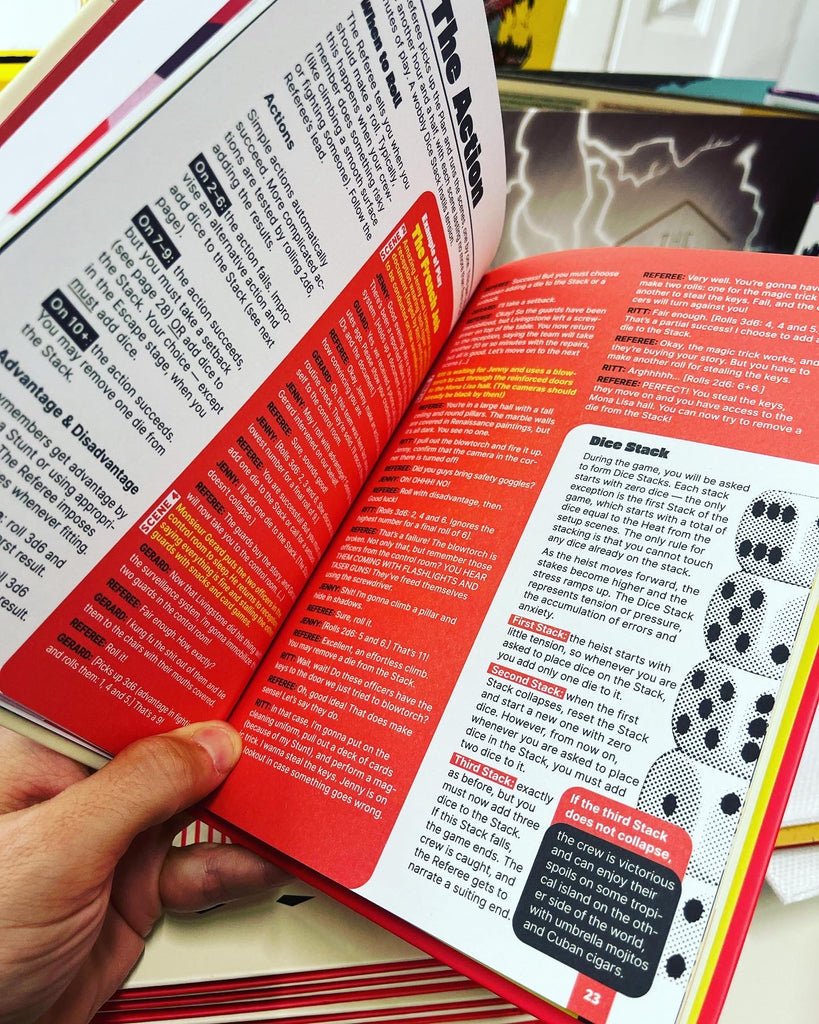



The Job + PDF
check_circle In Stock

The Job + PDF
Shipping Information
expand_more
Orders typically ship within 24-48 hours after being placed, business days only Monday - Friday. If you place an order on Friday, Saturday, or Sunday then it will not ship until the following business week. Shirts and Hoodies will ship separately.
We use USPS, UPS and DHL. Rates are based on current service rates and are subject to change. For the majority of items we ship in deluxe padded bubble mailers with bags and boards for added protection or with cardboard book mailers. Larger orders will be finely packed as well. We care about the product getting to you safe and secure.
You’re after the good stuff. Gems, diamonds, gold bullion, a Picasso painting, Fabergé eggs, the Queen’s crown. Nothing short will do. You live fast, think fast and move fast.
THE JOB is a stand-alone tabletop roleplaying game, inspired by movies such as Ocean's Eleven or the Italian Job, and games like Fiasco or Dread. It is designed for one-shot sessions. In conventional RPGs, winning or losing is irrelevant. This game, however, has a clear objective: to pull off a heist. You either do it, or you don’t. The game is played in two phases: Preparation and Action. In the first phase, players devise their master Plan and prepare their own session, simulating the experience of formulating a heist. In the second phase, they put their Plan into action and discover how (ill-)prepared they were. This phase is played with a wobbly dice stack that may fall with any failed action, potentially compromising the entire heist.
Inside you will find all the rules you need for character creation, gameplay, referee procedures and tools, five sample Briefs and guidelines on how you may use The Job as a side-quest for other (more traditional) games.
The Team:
Written by Andre Novoa.
Design by Guilherme Gontijo.
A5 hardback, 48 pages, high-quality print and paper. Includes PDF.





The Job: A Games Omnivorous Book Review
Introduction
The Job is a “low-prep” narrative role-playing game that emphasizes creativity and improvisation over detailed planning. Unlike many traditional RPGs, The Job focuses on the thrill of creating and executing heists. The game’s appeal lies in the player’s ability to plan intricate heists using imagination, real-world blueprints, or public domain resources. Players can either craft their own missions or use the example briefs and mission samples provided in the referee-only section of the book. The game is designed to be played with others, but it can easily be adapted for solo play.
Character Creation
Character creation is straightforward, offering eight fleshed-out roles that provide enough detail to inspire role-playing without overwhelming the player with information. For solo play, the game can be adapted by using simple mechanics like rolling 2d6 or 3d6 for advantage or disadvantage rolls, which dictate the success of actions. The absence of traditional stats makes The Job unique. Instead, characters rely on stunts unique to each role and use a dice stack to determine success or failure. Each character has four inventory slots, which are used to represent abstract items that can be pulled out as needed. This mechanic allows for spontaneous creativity and can lead to some entertaining and unexpected situations.
The Dice Stack and Setbacks
The dice stack mechanic represents the tension and pressure of the heist. Dice are added to the stack with each failure, and players must choose between accepting a setback or adding a die. Setbacks are obstacles that arise from failed actions, adding complexity and unpredictability to the game. These setbacks should be related to the current situation or bring back previously resolved issues to challenge the player.
Planning the Heist
Planning is central to The Job. The game breaks down heists into several components: the object to be stolen, its location, the budget, and six potential complications. The heist unfolds over 12 scenes, with specific complications arising in each phase. While referees usually provide details and budgets, solo players will need to devise these elements themselves. The game’s flexibility allows players to steal anything from real-world items to fictional treasures, making the game highly customizable.
Complications and Challenges
Complications are integral to the gameplay and provide opportunities for creativity. These could include guards, alarms, traps, or even environmental obstacles like mirrors and laser beams. While the game encourages players to tackle these challenges with innovative solutions, it’s important to remember that The Job is more about the experience than winning. The real fun comes from crafting a story filled with unexpected twists and turns.
Success and Failure
The ultimate success of a heist depends on maintaining control over the dice stack. If it collapses a third time, the heist fails, and the crew is caught. However, if players manage to keep the pressure down and overcome complications, they must still execute their escape in the final scenes. While the game lacks detailed mechanics and structures, it compensates with imaginative play and rich narrative opportunities. The Job relies on player creativity to fill gaps, which can sometimes disrupt the flow of the game. Despite this, the book is beautifully illustrated, well-written, and offers a unique concept that can be a delight for experienced solo players.
